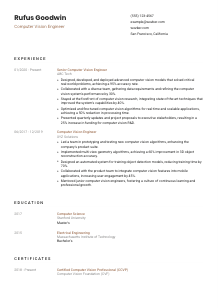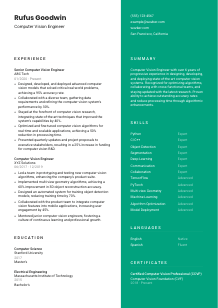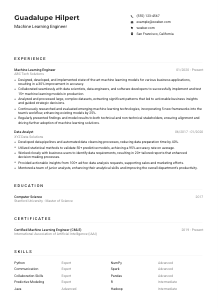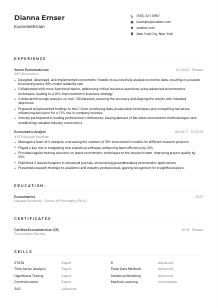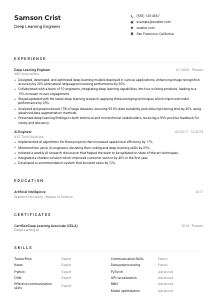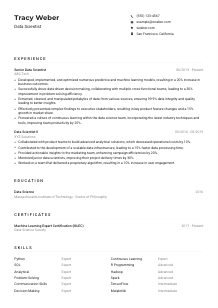Computer Vision Engineer Resume Example
Analyzing images, but your resume looks pixelated? Focus in on this Computer Vision Engineer resume example, rendered sharply with Wozber free resume builder. Discover how to align your algorithmic acumen with job requisites, making sure your career path is always in high definition!
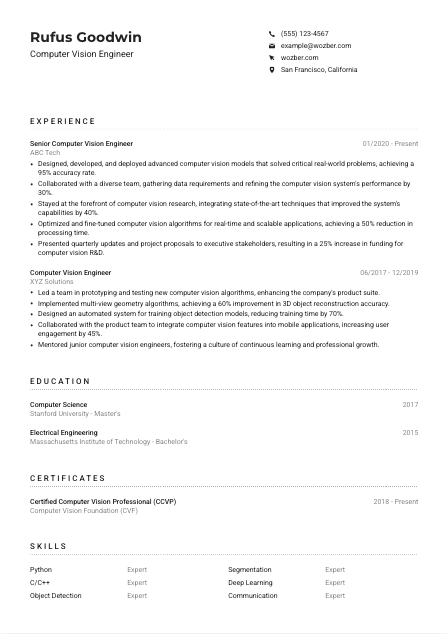
How to write a Computer Vision Engineer resume?
Hello, aspiring Computer Vision Engineer! The field of computer vision is on the cutting edge of technology, where your work becomes the eyes of machines, enabling them to recognize, analyze, and interpret the visual world. Crafting a resume that reflects your expertise in this innovative domain is crucial. Yet fret not, for with Wozber's free resume builder, we will guide you through tailoring your resume with a keen eye, just as you would refine an algorithm.
Ready to create a resume that not only passes through the Applicant Tracking Systems (ATS) with ease but also captivates your future employer? Let's begin this transformative journey together!
Personal Details
Your first encounter with an employer starts with your personal details. It's essentially the metadata of your professional persona. We'll ensure it's not only precise but frames you perfectly for a Computer Vision Engineer position.
1. Brand Yourself with Your Name
Think of your name as the title of your professional story. Ensure it's clearly visible, positioned at the top, making it the focal point of your introduction. A legible font will ensure it stands out without overpowering.
2. Job Title Precision
Identify with the role you're aiming for by placing "Computer Vision Engineer" beneath your name. This not only shows your focus but also aligns your resume with the specific position you're targeting, making it ATS-friendly.
3. Essential Contact Info
Your phone number and a professional email address (e.g., firstname.lastname@email.com) are must-haves. Triple-check for accuracy. And remember, in the tech world, a LinkedIn profile or GitHub repository link can showcase your projects and contributions, providing a deeper insight into your capabilities.
4. Location Matters
Given that our job specifies San Francisco, California, including this in your contact details validates your eligibility and reduces hiring complexities related to relocation.
5. Web Presence
If you have a professional portfolio or blog, include the URL. Make sure the content is up-to-date and showcases your expertise in computer vision and machine learning fields.
Takeaway
The Personal Details section is your resume's handshake. Make it professional, relevant, and a testament to your suitability for the Computer Vision Engineer role. Consider it your business card within the resume.





Experience
In the realm of computer vision, practical experience speaks volumes. Let's strategically structure your experience to reflect your mastery and alignment with the role's requirements.
- Designed, developed, and deployed advanced computer vision models that solved critical real‑world problems, achieving a 95% accuracy rate.
- Collaborated with a diverse team, gathering data requirements and refining the computer vision system's performance by 30%.
- Stayed at the forefront of computer vision research, integrating state‑of‑the‑art techniques that improved the system's capabilities by 40%.
- Optimized and fine‑tuned computer vision algorithms for real‑time and scalable applications, achieving a 50% reduction in processing time.
- Presented quarterly updates and project proposals to executive stakeholders, resulting in a 25% increase in funding for computer vision R&D.
- Led a team in prototyping and testing new computer vision algorithms, enhancing the company's product suite.
- Implemented multi‑view geometry algorithms, achieving a 60% improvement in 3D object reconstruction accuracy.
- Designed an automated system for training object detection models, reducing training time by 70%.
- Collaborated with the product team to integrate computer vision features into mobile applications, increasing user engagement by 45%.
- Mentored junior computer vision engineers, fostering a culture of continuous learning and professional growth.
1. Dissect the Job Description
Start with a fine-toothed comb through the job requirements, identifying keywords and phrases, such as "designed, developed, and deployed computer vision models." These are your golden nuggets for ATS optimization.
2. Highlight Relevant Positions
Arrange your roles in reverse-chronological order, emphasizing your contribution to the computer vision field. Even projects or roles that have tangentially touched upon machine learning or algorithm optimization are worth mentioning.
3. Impactful Accomplishments
Use bullet points to detail your achievements, e.g., "Optimized and fine-tuned computer vision algorithms for real-time and scalable applications." Quantify your impact wherever possible, as numbers often speak louder than words.
4. Quantify Your Impact
Adding metrics, like "achieved a 50% reduction in processing time," provides concrete evidence of your contributions and the value you brought to your past employers.
5. Relevance Is Key
Ensure every point made is directly linked to the world of computer vision engineering. Extraneous information can distract from your core competencies.
Takeaway
Your experience section is your proof of competence. By finely aligning it with the job requirements and making your impact quantifiable, you're not just a candidate; you're the solution they've been looking for.
Education
Education lays the cornerstone of your expertise in Computer Vision. Let's sculpt this section to not just meet but exceed the expectations for the Computer Vision Engineer role.
1. Align with Requirements
The job requires a "Master's degree in Computer Science" or similar fields. List your highest degree first, making sure it directly correlates with the job's specifications to get past the ATS.
2. Simplicity and Structure
Maintain clarity and brevity. For example, Stanford University, Master's in Computer Science, 2017. A clean structure aids in the ATS's readability of your resume.
3. Degree Relevance
Ensure your stated degrees directly reflect the preferences stated in the job description, such as "Master's degree in Computer Science, Electrical Engineering, or a related field." Exact matches can significantly enhance your resume's ATS score.
4. Supplementary Education
If you've taken additional courses or certifications relevant to computer vision or machine learning, even outside of your degrees, this is the place to list them. This shows ongoing commitment to your field.
5. Academic Achievements
Any standout academic achievements, such as awards, scholarships, or a notably high GPA, should be included here, provided they add value to your application for a Computer Vision Engineer role.
Takeaway
Your educational background is a badge of your technical knowledge and problem-solving skills. Tailor it to resonate with the job's demands, demonstrating you have the solid foundation required for the role.
Certificates
Certificates highlight your dedication to professional growth and specialization. They can be a significant differentiator, especially in a specialized field like Computer Vision Engineering.
1. Match Job Details
While the job description may not explicitly require certification, including relevant ones, such as "Certified Computer Vision Professional (CCVP)," showcases your commitment and specialized knowledge.
2. Pertinence Over Quantity
Choose to list those certifications that are most pertinent to the role. This ensures the hiring manager immediately sees your commitment to the cutting edge of computer vision.
3. Dates Matter
Providing the date of certification, especially for those recently acquired, underscores your initiative in staying current with evolving technologies.
4. Continuous Learning
The tech field evolves rapidly. Regularly updating your certifications and pursuing new ones demonstrates a growth mindset — crucial for a fast-paced field like Computer Vision Engineering.
Takeaway
Your certificates are a testament to your dedication and expertise in specific areas of Computer Vision Engineering. Include those that best reflect your proficiency and preparedness for the complexities of the role.
Skills
Your skills section is a condensed showcase of your capabilities. For a Computer Vision Engineer, this is where you detail your technical proficiency alongside essential soft skills.
1. Extract from Job Description
Carefully extract both the explicit and implied skills from the job description. Skills like "Strong proficiency in Python, C/C++" are keys to unlocking ATS doors.
2. Direct Alignment
List both hard and soft skills that you possess and that are mentioned in the job requirements, positioning the most relevant ones like "Deep Learning and Machine Learning" at the forefront.
3. Clarity and Focus
Resist the urge to flood this section with every skill you have. A focused list that speaks directly to the job description's requirements is far more impactful and ATS-compliant.
Takeaway
The skills section is a powerful snippet of what you bring to the table. Understanding and aligning it with what the job seeks not only affirms your suitability but also keenly positions you as a standout candidate.
Languages
In our interconnected, global market, language skills can enhance your attractiveness as a candidate, especially in roles requiring communication with international teams or documentation.
1. Review Job Necessities
The job explicitly requires "superior English language skills." Thus, your proficiency level here needs to be clear and truthful.
2. Showcase Language Proficiency
List English first, marking it as 'Native' or 'Fluent' to align with the job's requirements. Subsequently, listing additional languages you're proficient in can subtly hint at your adaptability and global mindset.
3. Other Languages
For a Computer Vision Engineer, speaking additional languages might not be a core requirement, but it's an added bonus. It speaks to your ability to collaborate in diversified teams.
4. Honesty is Key
Be accurate in assessing and depicting your level of proficiency for each language. Overestimation can lead to uncomfortable situations, underestimation to missed opportunities.
5. Understand the Role
Though our example role doesn't emphasize multilingual skills, being conversant in languages relevant to potential markets or research communities can enhance your appeal as a global professional.
Takeaway
Language skills can complement your technical proficiencies, showcasing you as a well-rounded candidate. They accentuate your resume, indicating readiness for roles that extend beyond local horizons.
Summary
Your resume's summary is its thesis statement—it needs to capture the essence of your professional narrative while aligning with the job at hand. Let's craft a summary that encapsulates your expertise as a Computer Vision Engineer.
1. Digest the Job Essence
Begin with internalizing the job description that asks for a "Computer Vision Engineer with over 3 years of industry experience." Use this as a foundation for your narrative.
2. Introduce Your Professional Self
Start your summary with a strong opening line that encapsulates your profession and years of experience. Highlight your specialization in computer vision right off the bat.
3. Highlight Key Achievements
Enumerate major achievements and skills that align with the job description. Mentioning specific outcomes, such as "achieving a 95% accuracy rate in computer vision models," makes your summary compelling.
4. Precision and Conciseness
Keep your summary concise and to the point, focusing solely on the aspects that make you the perfect candidate for the position. Aim for no more than 3-5 impactful lines.
Takeaway
Your summary is the hook of your resume; it is what persuades the hiring manager to delve deeper. Ensuring it's packed with precision and tailored to echo the job description sets you apart as the ideal Computer Vision Engineer candidate.
Embarking on Your Computer Vision Engineer Career Path
Congratulations! With these insights, you're equipped to craft a resume that transcends mere qualifications, embodying the essence of a Computer Vision Engineer. Let Wozber guide you with its ATS-friendly resume templates and free ATS resume scanner, refining your resume for a perfect match. It's time to position yourself not just as a candidate, but as the future of computer vision engineering. Your journey to impact begins now. Navigate your career path with confidence, and let's shape the future together!

- Master's degree in Computer Science, Electrical Engineering, or a related field.
- Minimum of 3 years of industry experience in computer vision and machine learning.
- Strong proficiency in Python, C/C++, and deep learning frameworks like TensorFlow or PyTorch.
- Expertise in state-of-the-art computer vision techniques such as object detection, segmentation, and multi-view geometry.
- Effective communication and collaboration skills with both technical and non-technical stakeholders.
- Must have superior English language skills.
- Valid work permit and must be located in San Francisco, California.
- Design, develop, and deploy computer vision models and algorithms to solve real-world problems.
- Collaborate with cross-functional teams to gather data requirements and refine the computer vision system's performance.
- Stay updated with the latest research, standards, and technologies in the field of computer vision and deep learning.
- Optimize and fine-tune computer vision algorithms for real-time and scalable applications.
- Present findings, updates, and project proposals to both internal and external stakeholders.





